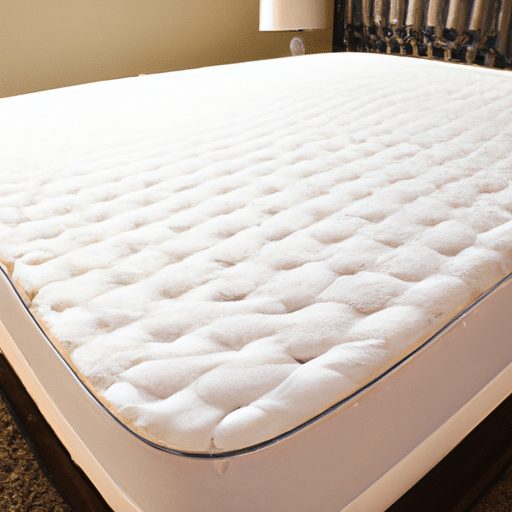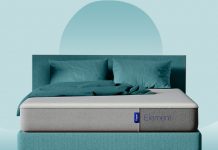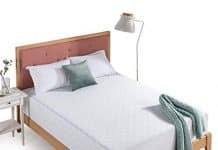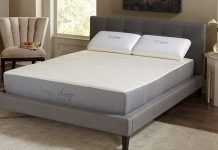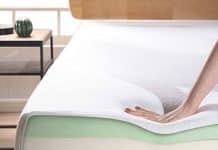Ladies and gentlemen, we bring you an enlightening article that unveils the mysteries behind one of our most beloved pieces of furniture: the mattress. Have you ever wondered what exactly goes into creating that perfect surface for a good night’s sleep? Look no further, for we are about to embark on a journey that will introduce us to the fascinating world of mattress materials. From memory foam to latex, and even the traditional innerspring, we will explore the characteristics, benefits, and drawbacks of each type. So, lay back, relax, and let us help you make an informed decision when choosing the perfect mattress material for your ultimate comfort.
Review contents
Innerspring
Definition
An innerspring mattress is a type of mattress constructed with a system of metal springs or coils that provide support and durability. These springs are surrounded by layers of padding and upholstery materials to enhance comfort.
Construction
Innerspring mattresses consist of a steel coil support system that forms the core of the mattress. The coils are interconnected or individually wrapped to minimize motion transfer and provide targeted support to different areas of the body. Surrounding the coil system, layers of padding, foam, and fibers are added to create cushioning and improve comfort.
Advantages
One of the key advantages of innerspring mattresses is their excellent support. The coil system evenly distributes body weight, which helps to relieve pressure points and ensures proper spinal alignment. Innerspring mattresses also offer excellent breathability, making them ideal for hot sleepers or those who live in warm climates. Additionally, these mattresses tend to have a bouncier feel and are often more affordable compared to other types of mattresses.
Disadvantages
While innerspring mattresses offer great support, they may not provide adequate motion isolation, especially if the coils are interconnected. This means that movements on one side of the bed can be felt on the other side. Innerspring mattresses also have a shorter lifespan compared to certain other mattress types. Over time, the coils may sag or lose their ability to provide optimal support, leading to discomfort and potential back pain.
Memory Foam
Definition
Memory foam mattresses are known for their ability to conform to the shape of the body, providing significant pressure relief and personalized comfort. Memory foam is made from a type of polyurethane foam that is infused with chemicals to increase its density and viscosity.
Construction
Memory foam mattresses typically consist of multiple layers, with the top layer being the memory foam itself. Underneath the memory foam layer, there may be additional layers of support foam or transition foam. The construction of memory foam mattresses can vary, with some models incorporating gel or other cooling materials to help dissipate heat.
Advantages
One of the notable advantages of memory foam mattresses is their ability to contour and mold to the body, relieving pressure points and providing customized support. This can be particularly beneficial for individuals with chronic pain or joint issues. Memory foam mattresses also excel at motion isolation, making them ideal for couples if one partner tends to move a lot during sleep. Additionally, memory foam mattresses are hypoallergenic and resistant to dust mites, mold, and other allergens.
Disadvantages
One common disadvantage of memory foam mattresses is their tendency to retain heat. The dense nature of memory foam can result in a warmer sleeping surface. However, many manufacturers now incorporate cooling technologies, such as gel infusion or open-cell foam, to help mitigate this issue. Memory foam mattresses can also have a slight initial odor, commonly referred to as “off-gassing,” although this typically dissipates within a few days. Some individuals may also find memory foam mattresses to be too conforming, lacking the desired level of support or bounce.
Latex
Definition
Latex mattresses are known for their resilience, support, and natural materials. Latex is a naturally derived material obtained from the sap of the rubber tree. It is highly durable and offers a unique combination of comfort and support.
Construction
Latex mattresses are typically constructed with layers of latex foam. The foam can be derived from natural, synthetic, or a blend of both types of latex. These layers may vary in thickness and density, providing different levels of support and firmness options. Some latex mattresses may also feature additional layers of foam or other materials for enhanced comfort.
Advantages
One of the key advantages of latex mattresses is their exceptional durability. Latex foam is resilient and maintains its shape and supportiveness for an extended period. These mattresses also offer excellent motion isolation and minimize disturbances caused by movements on the bed. Additionally, latex mattresses provide a buoyant and responsive feel, allowing for easy movement and repositioning during sleep. They are also naturally hypoallergenic, resistant to mold, dust mites, and other allergens.
Disadvantages
Latex mattresses can be relatively expensive compared to other mattress types. The cost is primarily attributed to the high-quality materials and manufacturing processes involved in creating latex foam. Some individuals may also find latex mattresses to be too firm, as they generally have a more solid feel compared to memory foam or innerspring mattresses. Additionally, those with latex allergies should be cautious and opt for hypoallergenic options or consult with their healthcare professional before purchasing a latex mattress.
Hybrid
Definition
Hybrid mattresses combine the benefits of different mattress materials, typically incorporating both innerspring coils and foam or latex layers. The goal is to create a mattress that provides the best features of each material and caters to a wide range of sleep preferences.
Construction
While the construction of hybrid mattresses can vary, they typically feature a pocketed coil system as the core for support. This coil system is then combined with layers of memory foam, latex, or other foam materials to provide comfort and pressure relief. The placement and thickness of these layers can vary depending on the desired level of firmness and support.
Advantages
Hybrid mattresses offer a balanced combination of support and comfort. The coil system provides excellent support, while the foam or latex layers offer contouring and pressure relief. This combination is particularly beneficial for individuals who prefer the traditional feel and bounce of an innerspring mattress but also desire the body-hugging sensation of foam or latex. Hybrid mattresses also often provide better motion isolation than traditional innerspring mattresses.
Disadvantages
One potential disadvantage of hybrid mattresses is their higher price point compared to other types of mattresses. The combination of different materials and the enhanced features can contribute to a higher cost. Hybrid mattresses can also be relatively heavy due to their construction, which may make moving or rotating them more challenging. Additionally, the specific feel and performance of a hybrid mattress can vary depending on the materials used, so it’s essential to test different models to find the right fit for individual preferences.
Gel
Definition
Gel mattresses feature a layer of gel-infused foam, often memory foam, within their construction. The gel infusion is intended to provide cooling properties and enhance the overall sleep experience by dissipating excess body heat.
Construction
Gel mattresses typically have a similar construction to memory foam mattresses, with a layer of gel-infused memory foam as the top comfort layer. This gel-infused foam is made by adding cooling gel particles to the foam during the manufacturing process. The remaining layers of the mattress, such as support foam or transition foam, contribute to the overall comfort and support.
Advantages
The key advantage of gel mattresses is their ability to regulate temperature better than traditional memory foam mattresses. The gel-infused foam helps to dissipate body heat and maintain a cooler sleep surface, promoting better sleep quality, especially for individuals who tend to sleep hot. Gel mattresses also offer the same benefits as memory foam mattresses, including superior pressure relief, motion isolation, and contouring.
Disadvantages
While gel mattresses can help alleviate the heat retention issue commonly associated with memory foam mattresses, some individuals may still find them to be too warm. The cooling effects of gel mattresses vary depending on the specific mattress brand and model. Additionally, the initial odor associated with gel-infused foam may be present, although it is generally less noticeable compared to traditional memory foam mattresses. It is also worth noting that gel mattresses can be more expensive than traditional memory foam mattresses due to the additional cooling properties.
Airbed
Definition
An airbed mattress, as the name suggests, utilizes air as the primary means of support. These mattresses allow individuals to adjust the firmness according to their preferences by inflating or deflating the air chamber within the mattress.
Construction
Airbed mattresses consist of one or multiple air chambers that serve as the primary support system. These chambers are typically made from robust and flexible materials, such as rubber or PVC. The air level can be adjusted using an integrated pump or a separate handheld controller. Surrounding the air chambers, comfort layers made of foam, latex, or other materials provide added cushioning and support.
Advantages
One of the significant advantages of airbed mattresses is their customizable firmness. Individuals can adjust the firmness level to their liking by adding or releasing air from the chambers. This feature is particularly beneficial for couples who have different firmness preferences. Airbed mattresses also provide excellent support and pressure relief, as the air chambers distribute body weight evenly. Additionally, these mattresses are highly durable and have a longer lifespan compared to other types of mattresses.
Disadvantages
Airbed mattresses may not offer the same level of contouring and body-hugging sensation as foam or innerspring mattresses. Some individuals may find the sensation of sleeping on air less preferable compared to the traditional feel of other mattress materials. In some cases, airbed mattresses may also produce noise when individuals adjust the firmness, which can potentially disrupt sleep. Additionally, airbeds with multiple chambers may pose a challenge in terms of finding the right balance between the chambers for ideal support and comfort.
Waterbed
Definition
Waterbed mattresses are filled with water and rely on the fluid support to provide comfort. These mattresses have been around for many years and offer a unique sleeping experience.
Construction
Waterbed mattresses consist of a large vinyl water chamber that is filled with water. The water chamber is enclosed within a fabric or foam layer, providing additional support and insulation. Some waterbed mattresses may have additional layers of foam or fiber to increase comfort and stability.
Advantages
One of the notable advantages of waterbed mattresses is their ability to conform to the body’s shape and provide customized support. The fluid support creates a gentle cradle that can relieve pressure points and minimize motion transfer. Waterbeds are also known for their excellent temperature control, as individuals can adjust the temperature of the water to suit personal preferences. Additionally, waterbed mattresses are highly durable and long-lasting, with a lifespan comparable to other high-quality mattress types.
Disadvantages
Waterbed mattresses require special maintenance and care compared to other mattress types. Ensuring the water chambers are properly filled and sealed is essential to prevent leaks. These mattresses can also be heavy and challenging to move due to the weight of the water. The unique construction and sensation of sleeping on a waterbed may not be suitable for everyone, as some individuals may find the movement or sloshing sensation uncomfortable during sleep. Additionally, waterbed mattresses may be harder to find and typically have limited options in terms of firmness and customization.
Pillow Top
Definition
A pillow top mattress is characterized by an additional layer of padding, traditionally referred to as a “pillow top,” attached to the top of the mattress. This layer provides extra cushioning and a plush feel.
Construction
Pillow top mattresses typically consist of an innerspring or foam core with a soft layer of padding stitched on top. The padding material can vary and may include materials like memory foam, latex foam, or cotton. A pillow top can be added to mattresses of varying firmness levels to create a more luxurious and plush sleeping surface.
Advantages
The main advantage of pillow top mattresses is their enhanced comfort and plushness. The additional layer of padding offers extra cushioning and contouring, providing a more enveloping sensation and relieving pressure on sensitive areas. Pillow top mattresses also tend to have increased breathability and airflow, which helps to regulate body temperature during sleep. Additionally, pillow top mattresses are widely available in a range of firmness options, making it easier for individuals to find the desired level of support.
Disadvantages
One potential disadvantage of pillow top mattresses is their tendency to have a shorter lifespan compared to other mattress types. The extra padding can compress over time, leading to sagging and reduced support. Additionally, pillow top mattresses may be more expensive than standard mattresses due to the additional materials and craftsmanship involved. Some individuals may also find that the plushness of a pillow top mattress makes it too soft, lacking proper support for their back or alignment.
Foam
Definition
Foam mattresses are constructed primarily with foam materials, such as polyurethane foam or memory foam. These mattresses are known for their contouring properties and support, providing a comfortable and pressure-relieving sleep surface.
Construction
Foam mattresses typically consist of multiple layers of foam. The specific arrangement and thickness of these layers can vary, depending on the desired firmness and support level. The top layer frequently includes memory foam or a similar material that conforms to the body’s shape, while the underlying layers provide additional support and stability. Some foam mattresses may also incorporate cooling technologies or gel infusion to help dissipate heat.
Advantages
One of the significant advantages of foam mattresses is their ability to conform and mold to the body, relieving pressure points and promoting spinal alignment. Foam mattresses offer excellent motion isolation, making them suitable for couples or individuals who are easily disturbed by their partner’s movements. These mattresses are also hypoallergenic, resistant to dust mites, and have minimal noise potential. Foam mattresses often come with a wide range of firmness options to accommodate different sleep preferences.
Disadvantages
Foam mattresses can retain heat, especially those without cooling technologies incorporated. The dense nature of foam can trap body heat, resulting in a warmer sleep surface. However, many manufacturers now offer foam mattresses with enhanced breathability and cooling properties. Some individuals may also find foam mattresses to be too conforming. While foam provides excellent pressure relief, it may lack the desired level of support or bounce for certain sleepers. Additionally, foam mattresses may have a slight off-gassing odor upon initial use, although it typically dissipates within a few days.
Organic
Definition
Organic mattresses are made from natural materials that are free from synthetic chemicals, pesticides, and harmful additives. These mattresses prioritize sustainability and environmental consciousness, making them popular among those seeking eco-friendly sleep solutions.
Materials Used
Organic mattresses can be constructed using various natural materials, including organic cotton, organic wool, natural latex, and organic plant-based foams. These materials are grown, processed, and manufactured without the use of synthetic fertilizers, pesticides, or chemicals.
Advantages
One of the significant advantages of organic mattresses is their reduced exposure to harmful chemicals and toxins. The use of natural materials ensures a healthier sleep environment, especially for individuals with allergies or sensitivities. Organic mattresses are also typically highly durable and long-lasting, thanks to the quality of the materials used. Furthermore, these mattresses often have excellent breathability and moisture-wicking properties, keeping sleepers cool and comfortable throughout the night.
Disadvantages
Organic mattresses may come with a higher price tag compared to conventional mattresses due to the use of premium and eco-friendly materials. The limited availability and higher production costs of organic materials contribute to this cost difference. Additionally, organic mattresses may have specific care requirements or limitations. For example, certain materials, like natural latex or wool, may require more delicate cleaning methods. Lastly, the firmness options for organic mattresses may be relatively limited compared to mattresses made with synthetic materials. Individuals seeking a specific level of firmness may need to explore different organic models to find the suitable fit.

